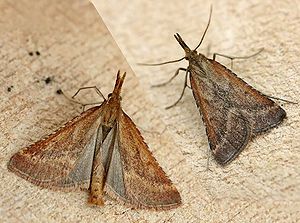Synaph
| Synaph | ||||||||||||
|---|---|---|---|---|---|---|---|---|---|---|---|---|

|
||||||||||||
| Systematics | ||||||||||||
|
||||||||||||
| Scientific name | ||||||||||||
| Synaph | ||||||||||||
| Huebner , 1825 |
The genus Synaphe is a genus of butterflies from the family of the borer (Pyralidae), within the superfamily Pyraloidea . There are around 10 species in Europe, four species in German-speaking countries.
features
The species of the genus Synaphe reach a wingspan of 18 to 36 millimeters. The fore wings are long and narrow, more pronounced in the females than in the males. Usually the costal edge is slightly concave. The light outer line is clearly developed in all species, usually a little curved and often also jagged. The inner line, on the other hand, is often indistinct and can also be missing in some species. The basic color of the upper side of the forewings is a light to dark brown, which in some species can also be ocher or slightly yellowish-brown. The drawing elements, inner line, outer line and disc and marginal spots, if any, are significantly lighter than the basic color, mostly whitish to yellowish. In some species the drawing continues on the hind wings, in other species the hind wings are almost uniformly colored. The females of all species are usually a little lighter in color than the males. The antennae of the males are long and double-combed, the antennae of the females, however, are simple and thread-shaped.
Distribution and occurrence
The species of the genus have their distribution center in southern Europe, Asia Minor and North Africa, but occur partly over Central Asia to the Pacific coast . They prefer dry and warm locations overgrown with grasses. In Germany there is only one species ( Synaphe punctalis ). In three other species, the distribution area extends from south-eastern Europe to Austria.
Way of life
The moths are mostly diurnal and nocturnal. The caterpillars feed mainly on grass , more rarely on moss and various herbs . Often spine tubes are placed on the food plants or in the ground. The development cycle of some species is poorly known.
Systematics
10 species have been found in Europe:
- Synaphe antennalis ( Fabricius , 1794)
- Synaphe bombycalis ([ Denis & Schiffermüller ], 1775) - with three subspecies: Synaphe bombycalis bombycalis , Synaphe bombycalis provincialis ( Duponchel , 1833) and Synaphe bombycalis asiatica Obraztsov , 1952
- Synaphe diffidalis ( Guenée , 1854)
- Synaphe interjunctalis ( Guenée , 1854)
- Synaphe lorquinalis ( Guenée , 1854)
- Synaphe moldavica ( Esper , 1794) - with three subspecies: S. moldavica moldavica , S. moldavica aberralis ( Guenée , 1854) and S. moldavica netricalis ( Hübner , 1813)
- Synaphe morbidalis ( Guenée , 1849)
- Synaphe oculatalis ( Ragonot , 1885)
- Synaphe predotalis ( Zerny , 1927) - e.g. In some cases it is only understood as a subspecies of the African species S. chellalalis ( Hampson , 1900)
- Synaphe punctalis ( Fabricius , 1775)
swell
literature
- Frantisek Slamka: Pyraloidea of Europe / Europa (Lepidoptera) Volume 1 Pyralinae, Galleriinae, Epipaschiinae, Cathariinae & Odontiinae. 138 pp., Bratislava 2006, ISBN 80-969052-3-6